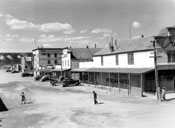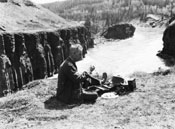 |
back to main story | |
| Whitehorse - Community Profile | ||
|
The first non-Native to pass through the Whitehorse area was probably a prospector named George Holt in 1878. However, the first Native inhabitants arrived about 8,000 years before him, not long after the last of the ice-age glaciers retreated. The future site of the city lay along a well-traveled corridor between Marsh Lake and Lake Laberge. Native traders from coastal villages passed through on their way to exchange goods with natives of the Yukon's interior. The Yukon River here was a rich source of salmon and the surrounding mountains provided big game, including bison and caribou.
Though now the capital of the Yukon, Whitehorse languished in the shadow of Dawson City for half a century. Dawson remained the capital until 1953. Initially Whitehorse's main function was to serve as a transportation hub. That role fell to the city by default thanks to nearby White Horse Rapids and Miles Canyon. These river hazards forced early travelers from the coast to unpack their boats and ship their goods overland on horse-drawn tramway carts. The trip around the canyon and rapids covered only a few kilometres downriver, where stampeders reloaded their boats. Settlements popped up at both ends of the portage - Canyon City to the south, White Horse to the north. Rusting cans and depressions in the earth are about all that remain of Canyon City, which once boasted a NWMP post, hotel, houses, stable and workshops. Whitehorse, however, continued to grow thanks the White Pass and Yukon Route Railway: its narrow-gauge tracks from the Lynn Canal at Skagway ended here. Freight and passengers from the trains were reloaded on steamships for the trip downriver to Dawson City and Fort Yukon.
| ||
 |
back to main story | |

